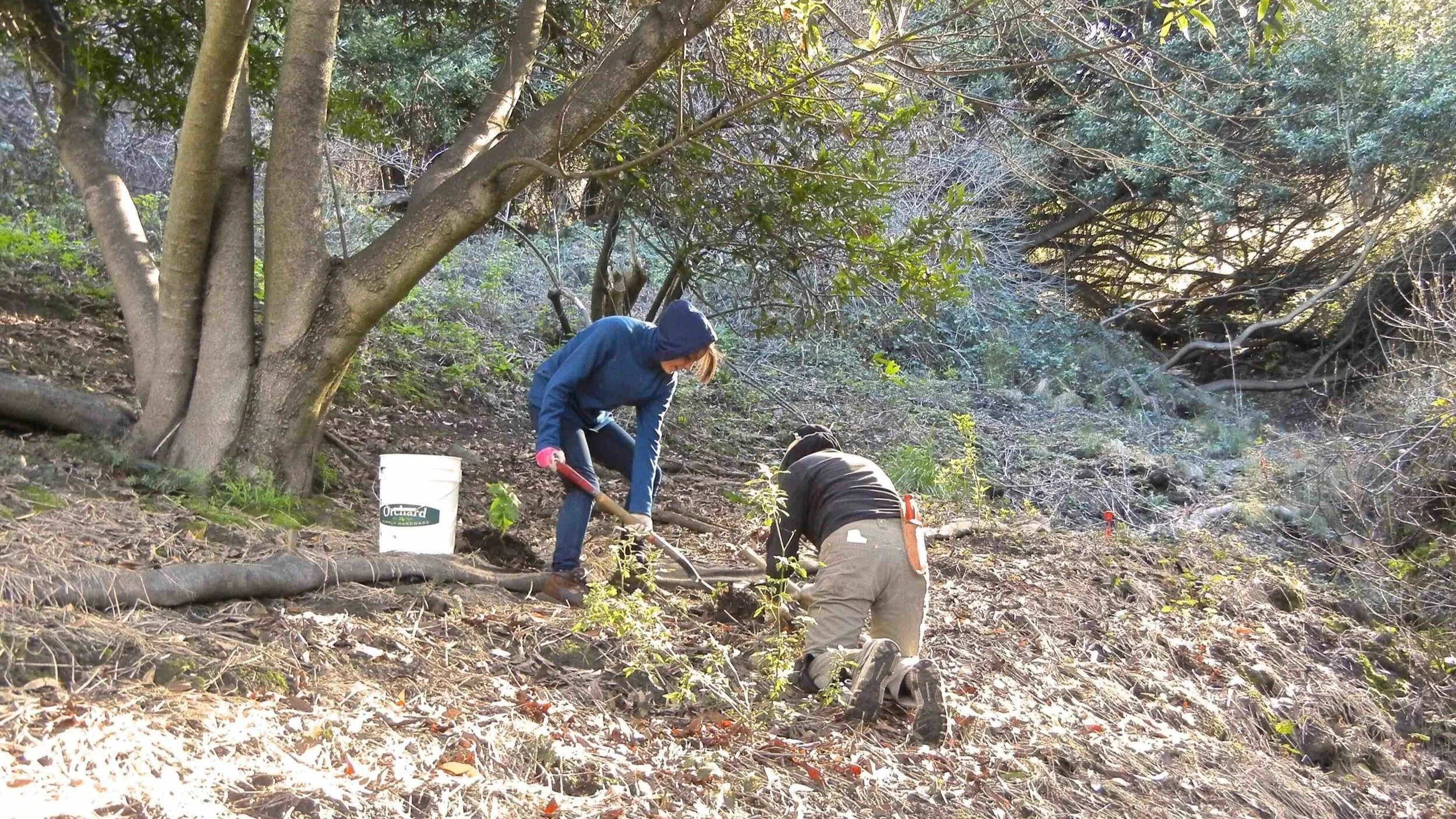if you haven’t delved into the wonders of Garber Park, you need to know about it! You will find a delightful native oak woodland with native fern grottoes, giant coast live oaks, California buckeyes, California big leaf maples, and a fascinating old defunct replace from old boy scout days of the 1920’s! All this is within walking distance from the intersection of Ashby and Claremont avenues.
Making a difference, Conservancy President Tim Wallace
Tim Wallace considers himself a “Yes man”—not a person that caves into other people's demands, but the kind that says, “Yes” to life.
Tim just celebrated 15 years (on and off—mostly on) as president of the Claremont Canyon Conservancy, "Working with volunteers we have helped make the canyon more fire-safe, more natural, and more accessible by trails.”
Tim has been involved with natural resources all his life: first as rancher and logger, then later in academics. He has been at UC Berkeley since 1963. "I've worked at the White House on agricultural matters and was Director of California's Department of Food and Agriculture. I've done consulting abroad in Europe, Latin America, Africa, the Far East, and New Zealand and Australia."
Big Cats in Claremont Canyon, by Janis Bankoff
A new study conducted by the East Bay Regional Park District reveals the presence of mountain lions (“Big Cats”), an elusive apex predator utilizing the wilderness ridegtop above the Caldecott Tunnel to transit between the open spaces north and south of the tunnel. The study, expanded earlier this year to include the Caldecott Tunnel Corridor, is led by veteran Park District wildlife ecologist and science consultant Steve Bobzie
Daughter fights fire, by Gerry Keenan
Newest Lichen for Claremont Canyon, by Kay Loughman
At the invitation of the Conservancy, in 2009 members of the California Lichen Society surveyed lichens at sixteen sites in Claremont Canyon. Read a report of the survey in the Conservancy’s Fall 2009 Newsletter. In all, 81 lichen species were identified. The results of the survey . . .
Winter Bird Walk with Dave Quady, December 11, 2016, by Kay Loughman
Alameda whipsnake/striped racer research project, by Jessica Sheppard
Claremont Canyon Regional Preserve is hosting a research project focused on the Alameda whipsnake (Masticophis lateralis euryxanthus), also sometimes referred to as the Alameda striped racer (Coluber lateralis euryxanthus). This elusive and speedy snake is protected at the state and federal level and may be found in the park.
Art installation features view from Claremont Canyon, by Marilyn Goldhaber
Spring in the canyon and update on fire safety work, by L. Tim Wallace
Keeping abreast of Claremont Canyon, by Marilyn Goldhaber
There are many ways to keep abreast of the goings-on in Claremont Canyon—and also in its surrounding neighborhoods. If you are interested mainly in the wildlands of Claremont Canyon and the activities of the Claremont Canyon Conservancy, including our hikes, stewardship projects, trail upkeep, and wildfire safety, we have a monthly one-page newsletter that we send out by email to our members and anyone else who signs up for the service.
Winter bird walk with Dave Quady, by Kay Loughman
Restoring a north coastal grassland, by Marilyn Goldhaber
Spring Bird Walk: this morning in Claremont Canyon, by Dave Quady
Birds and birding in Claremont Canyon, by Kay Loughman
Winter birding field trip, by Kay Loughman
A botanical exploration with Lech Naumovich, by Marilyn Goldhaber
Native plants at the Pacifica site with Jake Sigg, by Marilyn Goldhaber
A DOZEN CONSERVANCY MEMBERS AND FRIENDS visited the Pacifica Foundation site of the KPFA Radio Towers overlooking Gwin and Claremont Canyons, with Jake Sigg, long-time advocate of native plant restoration in the Bay Area and author of the widely read “Nature News from Jake Sigg.” Jake helped us identify native plants and provided insights on the landscape, a naturally rough and exposed knoll overlooking much of the bay area to the west and Mount Diablo and the inner valley to the east.
Found: 1895 Alameda-Costra county boundary marker, by Mary Millman
SOMETIMES IMPORTANT THINGS end up in unexpected places. In 1895 several 400-pound cast iron boundary markers were placed along the ridgetop boundary between Alameda County and Contra Costa County. One was positioned right at the top of Claremont Canyon, close to what we know as “Four Corners,” the intersection of Grizzly Peak Boulevard and Claremont Avenue/Fish Ranch Road.
Twentieth century canyon dwellers, by Mary Millman
ALTHOUGH WE ARE NOW IN THE MIDST of a comprehensive project to collect an audio history of Claremont Canyon, the beginnings sprang from a casual curiosity about the early days in the canyon. Our board member, Tamia Marg, who spent her childhood there remembered “Tappy” Marron, whose family built the house that the Park District now occupies at the end of Gelston Road.
Wild life in the North Hills - the website, by Kay Loughman
A year or two ago I was greatly influenced by a couple of books (“Bowling Alone” and “Better Together”) by a Harvard scholar named Robert D. Putnam. He makes the case that decreasing involvement in community life is bad for individuals and ultimately bad for the world—a gross oversimplification on my part. But, as one who tends to sit at the computer by myself rather than do anything in the community, I knew Putnam’s message was aimed at people like me

